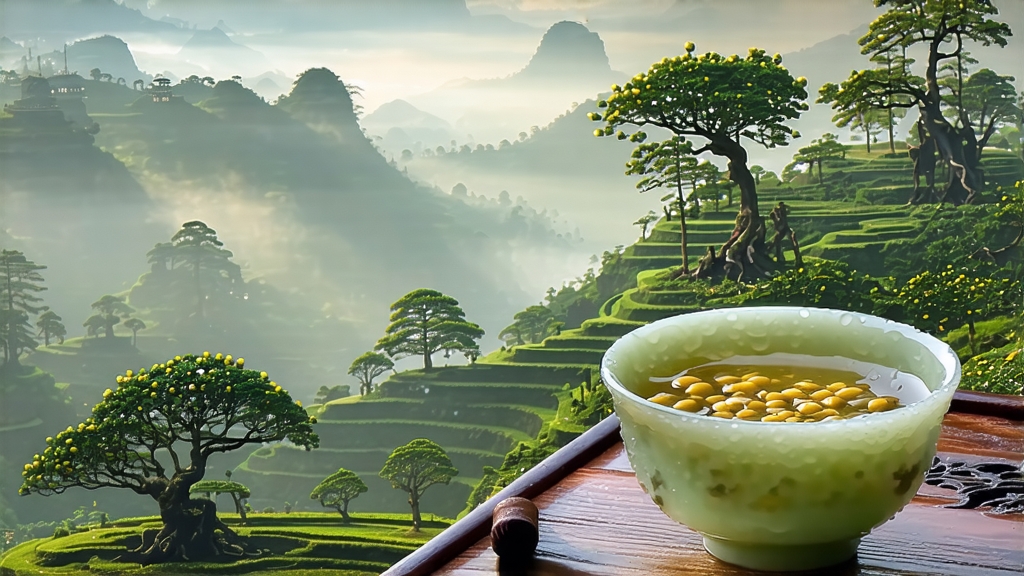
Tucked high above the Sichuan basin where the Min River carves clouds into stone, Meng Ding Huang Ya has been quietly perfecting its golden hue for twelve centuries. International drinkers often greet yellow tea with a polite nod, mistaking it for a pale green cousin; yet one sip of this bud-level rarity reveals a flavor that seems to have borrowed the creaminess of Assam, the orchid lift of high-mountain oolong, and the mineral whisper of spring water itself. To understand why the tea almost vanished during the twentieth century—and why Chinese connoisseurs now guard it like liquid jade—we must follow the leaf from Tang-dynasty court records to the mist-locked terraces of Mount Meng, then into the cup where it finally unfurls its lemon-yellow banner.
Historical scrolls first mention “Mengding Stone Flower” in 808 CE, when the Buddhist monk Gan Lu (“Sweet Dew”) planted seven tea bushes on the summit as an offering to the mountain spirits. By Song times the sprouts were pressed into cakes, steamed, and sent downriver to Kaifeng in silver-lined crates; the emperor Huizong, himself a skilled tea artist, declared the liquor “the color of first morning light on palace tiles.” When Ming taste turned against compressed tea, Mount Meng switched to loose leaf, and the buds—protected from full green fixation—began to yellow naturally during a slow, covered sweat. The Qing court institutionalized this accident: every spring, 360 grams of the smallest buds traveled 1 800 km to Beijing, packed in goose-feather cushions, arriving still fragrant from mountain fog. With the fall of the empire the tribute system collapsed, and Meng Ding Huang Ya retreated into monastic memory until the 1980s, when state agronomists rediscovered 200 ancient mother trees hidden behind a Taoist shrine.
Botanically the tea belongs to the local Sichuan small-leaf landrace, Camellia sinensis var. sinensis ‘Mengding’. Growers recognize three picking grades: “Gold Needle” (single bud, 6–8 mm), “Yellow Bud” (bud with half-open first leaf), and “Yellow Slice” (bud plus two leaves). Only the first two are exported under the protected geographical indication; anything larger becomes generic Mengding green. The real magic lies in the microclimate: at 1 450 m above sea level, morning clouds act like a natural shade cloth, slowing photosynthesis and boosting theanine. Night temperatures can drop 12 °C within hours, locking floral volatiles inside the fragile bud. Soil is a crumbly quartz-rich phyllite that drains instantly yet holds just enough moisture to keep the roots cool; walk the terraces after rain and you hear a soft crunch underfoot—mica flakes shattering like champagne glass.
Crafting Meng Ding Huang Ya is a four-day choreography of heat, moisture, and breath. Picking starts before dawn on the 88th day after the spring equinox, when local legend says “the mountain exhales.” Women snap the buds with a twist that leaves the tiny fish-leaf attached; anything bruised is rejected because the yellowing process magnifies flaws. The first firing—called “kill-green” in green-tea parlance—here lasts only 90 seconds at 160 °C, enough to halt oxidative enzymes but not to drive off all green character. While still warm, the leaf is wrapped in stacks of linen towels and placed inside a bamboo steam box lined with wet cedar planks. For the next 36 hours the tea “sweats,” oxidizing slowly in the dark; every three hours the master unwraps the bundle, fluffs the buds, and checks aroma for the transition from fresh pea to roasted chestnut. When the leaf edges turn primrose and the stem snaps with a faint caramel note, the second low-temperature bake fixes the color at 80 °C. A final charcoal finish over mountain oak lends a whisper of smoke that evaporates within weeks, leaving behind a scent that connoisseurs liken to “milk-steeped orchid.”
Western brewers often treat yellow tea like a delicate green, then complain of thinness. The leaf is actually denser; its cell walls remain partially intact after the sweat, so it demands higher heat to awaken. Start with a pre-warmed gaiwan of 120 ml, 4 g of buds, and 90 °C water. The first infusion—15 seconds—releases a pale